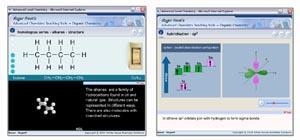Allison Prior reviews this CD-ROM aimed at GSCE and A-Level specifications
Roger Frost's organic chemistry teaching tools
Roger Frost
Cambridge: ilearnchemistry 2006 | Editions available for standalone computers and network servers

This CD-ROM is designed as an interactive teaching tool for tackling carbon chemistry at Key Stages 4 and 5. Using animations, puzzles, mechanisms and models, the package aims to provide a set of 'lecture notes' where the words have been replaced by pictures. The resource provides over 250 Flash-animated slides and five-plus hours of two-minute long animations, illustrating the main topics in organic chemistry. The software is intended to be used as either a direct teaching tool where the teacher discusses the slides with the students or as a student-based resource where the students use the slides as prompts to write notes.
The slides and animations are clear and easy to follow and the CD-ROM easy to navigate. Each topic is covered in detail with, for example, 20 slides on alkenes. Each slide can also be matched exactly to most GCSE, iGCSE and A-level specifications.
As a direct teaching tool, the animations and slides are fantastic. With most classrooms now dominated by interactive whiteboards students are no longer expected to visualise conceptually difficult ideas and teachers are no longer expected to provide elaborate models. Appropriate images are available on the Internet but this resource is comprehensive, clearly laid out and better than many others I've seen.
I particularly like the layout of the slides because they are not crowded with text, which allows students to concentrate on what is being explained and the image presented. Topics covered well include protein synthesis and reaction mechanisms such as the chlorination of alkenes.
This package also provides an excellent resource to observe complex practicals, such as the chlorination of methane, without the usual safety implications. There are also great three dimensional models, using the program Chime, to show concepts such as stereoisomerism or electron orbitals.
Where I feel this software falls down is as a student-based resource. Since each slide or animation contains little or no text students would have to use the CD-ROM in conjunction with a textbook or a teacher would need to offer appropriate support/direction for them to produce any meaningful notes. I feel this would be difficult to manage in a classroom scenario because the slides do not match directly with any textbook.
Related Links
Roger Frost's teaching tool









No comments yet